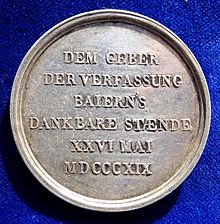
Back Verfassung des Freistaates Bayern German Constitution de l'État libre de Bavière French Constituição da Baviera Portuguese


 |
|---|
The Constitution of the Free State of Bavaria was enacted on 8 December 1946. It is the fourth constitutional document in Bavarian history after the Constitution of 1808, the Constitution of the Kingdom of Bavaria in 1818 and the Bamberg Constitution of 1919.
The first state elections after the 2nd World War were held on 30 June 1946, when 180 members of a Constituent Assembly were chosen. The constituent assembly was tasked with drafting a new Bavarian constitution and passed a first draft for a constitution on 20 September 1946. After the American military government vetoed some provision, a final draft was passed with 136–14 votes on 26 October 1946. The new constitution was accepted by a public vote on 1 December 1946, the same day as the state election for the first Bavarian State Parliament after the 2nd World War.[1] The constitution entered into force upon its publication in the official Bavarian government gazette on 8 December 1946.
The Constitution of the Free State of Bavaria regulates the independence of the Free State (Republic) as a Land of the Federal Republic of (Germany). The Constitution is divided into four main parts and contains a total of 188 articles. In the first three articles, it is set that Bavaria is a free state, that authority emanates from the people and that Bavaria is a legal, cultural and social state.
The Constitution can be changed only in the way of legislation (article 75). Resolutions of the Parliament to amend the Constitution must be submitted to the people for a decision.
© MMXXIII Rich X Search. We shall prevail. All rights reserved. Rich X Search